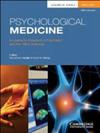多少或多频繁?在青少年人群样本中检验 DSM 交叉症状测量的筛查特性
IF 5.9
2区 医学
Q1 PSYCHIATRY
引用次数: 0
摘要
背景 DSM 一级症状交叉测量法(DSM-XC)可评估多个精神病理学领域。然而,它在人群样本中筛查精神障碍的能力以及副词框架(强度和频率)对其表现的影响尚不清楚。方法 该研究基于 1993 年巴西佩洛塔斯出生队列的横截面数据。研究对象包括已完成 DSM-XC 和结构化诊断访谈的参与者(n = 3578,年龄 22 岁,53.6% 为女性)。对检测五种内化性障碍(双相情感障碍、广泛焦虑障碍、重度抑郁障碍、创伤后应激障碍和社交焦虑障碍)和三种外化性障碍(反社会人格障碍、注意力缺陷/多动障碍和酒精使用障碍)的 13 个 DSM-XC 领域中每个领域的敏感性、特异性、阳性(LR+)和阴性(LR-)似然比进行了估算。敏感性和特异性分别为 0.75、LR+ >2 和 LR- <0.5。计算值适用于 DSM-XC 的原始评分和副词框架。结果 DSM-XC 的几个领域显示出有意义的筛查特性。焦虑领域对所有内化障碍的敏感度和 LR 值均可接受。自杀意念、精神病、记忆、重复性想法和行为以及分离领域对所有障碍都显示出可接受的特异性。对于内化性障碍,该领域也产生了较小但有意义的 LR+ 值。然而,LR+ 和 LR- 值对于外化性障碍一般没有意义。频率框架问题改善了筛查特性。结论 DSM-XC 领域显示了跨诊断筛查特性,对社区内化障碍的可能性提供了微小但有意义的变化,与症状强度相比,通过询问症状频率可以改善筛查特性。目前,DSM-XC 缺乏有意义的外化障碍领域。本文章由计算机程序翻译,如有差异,请以英文原文为准。
How much or how often? Examining the screening properties of the DSM cross-cutting symptom measure in a youth population-based sample
Background The DSM Level 1 Cross-Cutting Symptom Measure (DSM-XC) allows for assessing multiple psychopathological domains. However, its capability to screen for mental disorders in a population-based sample and the impact of adverbial framings (intensity and frequency) on its performance are unknown. Methods The study was based on cross-sectional data from the 1993 Pelotas birth cohort in Brazil. Participants with completed DSM-XC and structured diagnostic interviews (n = 3578, aged 22, 53.6% females) were included. Sensitivity, specificity, positive (LR+), and negative (LR−) likelihood ratios for each of the 13 DSM-XC domains were estimated for detecting five internalizing disorders (bipolar, generalized anxiety, major depressive, post-traumatic stress, and social anxiety disorders) and three externalizing disorders (antisocial personality, attention-deficit/hyperactivity, and alcohol use disorders). Sensitivities and specificities >0.75, LR+ > 2 and LR− < 0.5 were considered meaningful. Values were calculated for the DSM-XC's original scoring and for adverbial framings. Results Several DSM-XC domains demonstrated meaningful screening properties. The anxiety domain exhibited acceptable sensitivity and LR− values for all internalizing disorders. The suicidal ideation, psychosis, memory, repetitive thoughts and behaviors, and dissociation domains displayed acceptable specificity for all disorders. Domains also yielded small but meaningful LR+ values for internalizing disorders. However, LR+ and LR− values were not generally meaningful for externalizing disorders. Frequency-framed questions improved screening properties. Conclusions The DSM-XC domains showed transdiagnostic screening properties, providing small but meaningful changes in the likelihood of internalizing disorders in the community, which can be improved by asking frequency of symptoms compared to intensity. The DSM-XC is currently lacking meaningful domains for externalizing disorders.
求助全文
通过发布文献求助,成功后即可免费获取论文全文。
去求助
来源期刊

Psychological Medicine
医学-精神病学
CiteScore
11.30
自引率
4.30%
发文量
711
审稿时长
3-6 weeks
期刊介绍:
Now in its fifth decade of publication, Psychological Medicine is a leading international journal in the fields of psychiatry, related aspects of psychology and basic sciences. From 2014, there are 16 issues a year, each featuring original articles reporting key research being undertaken worldwide, together with shorter editorials by distinguished scholars and an important book review section. The journal''s success is clearly demonstrated by a consistently high impact factor.
 求助内容:
求助内容: 应助结果提醒方式:
应助结果提醒方式:


